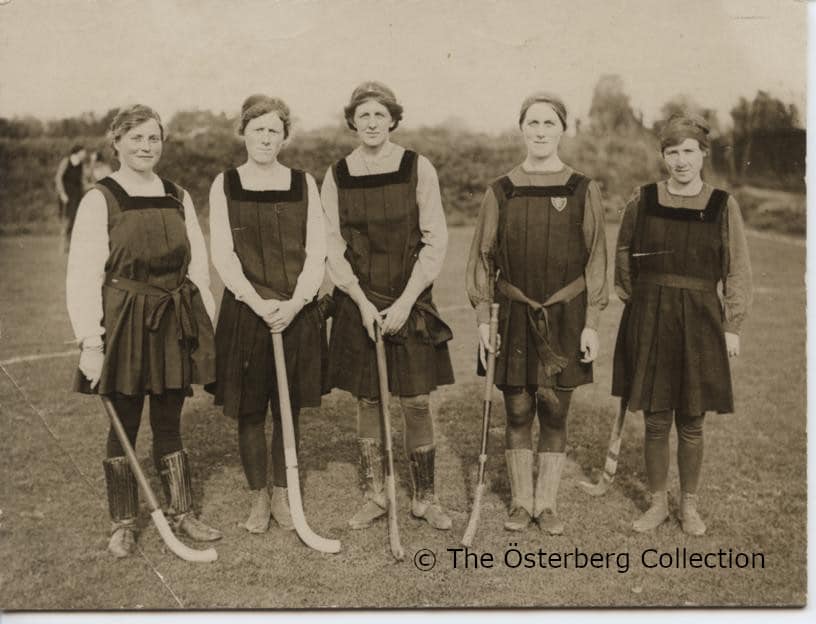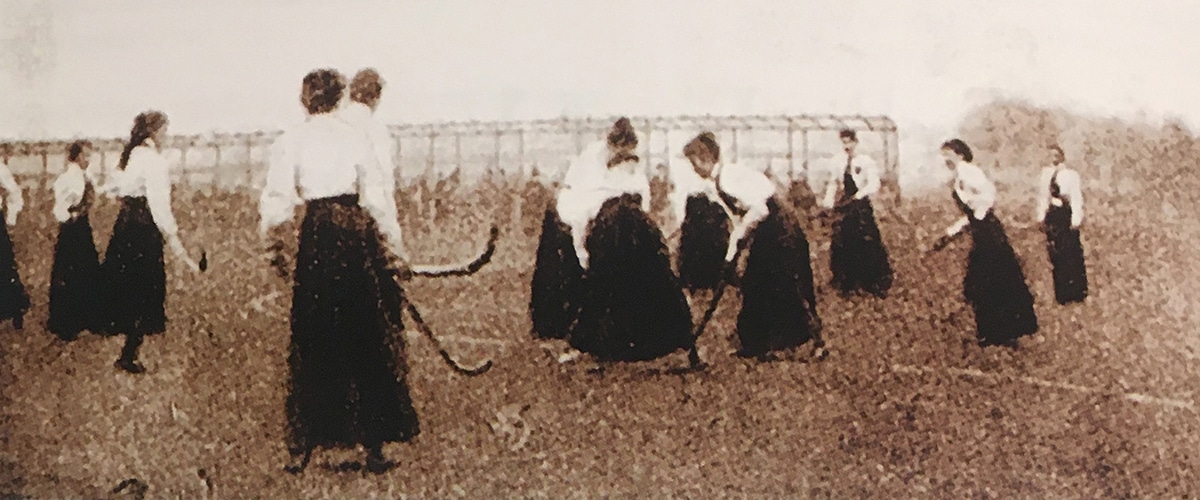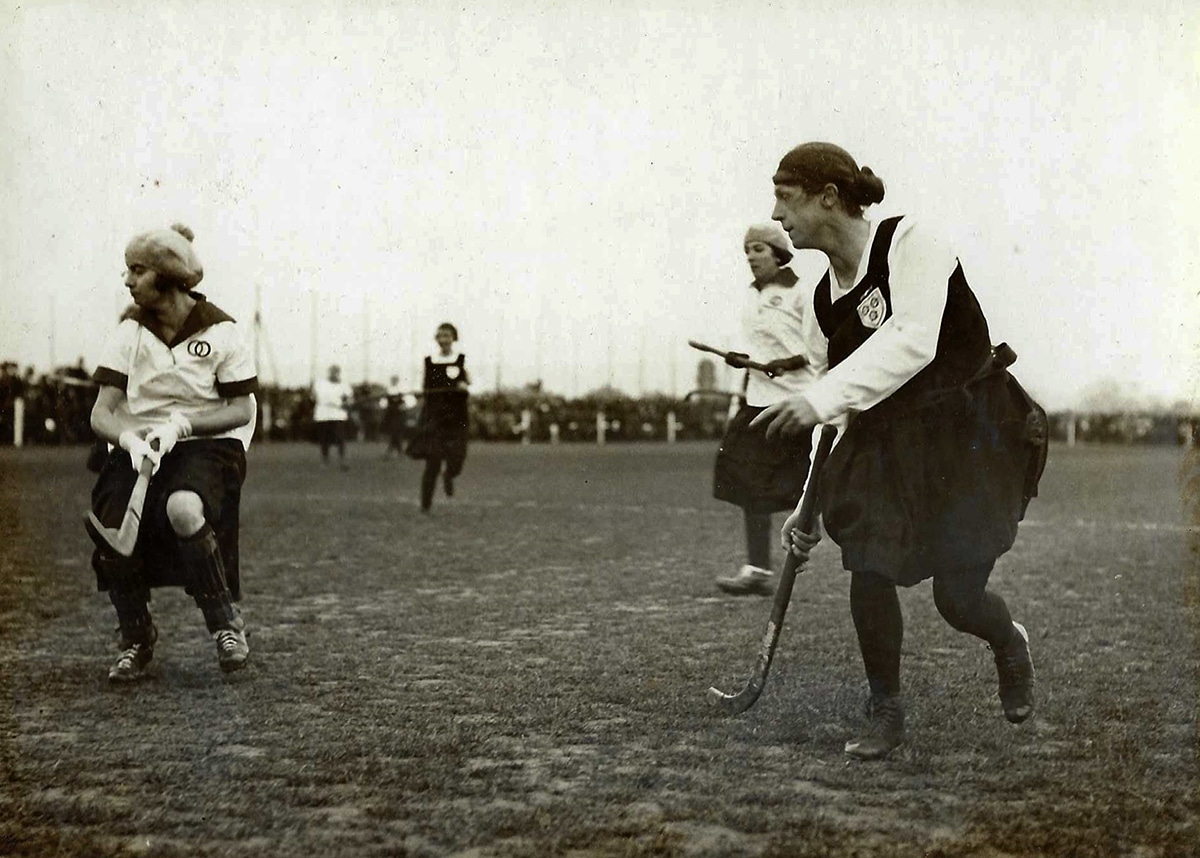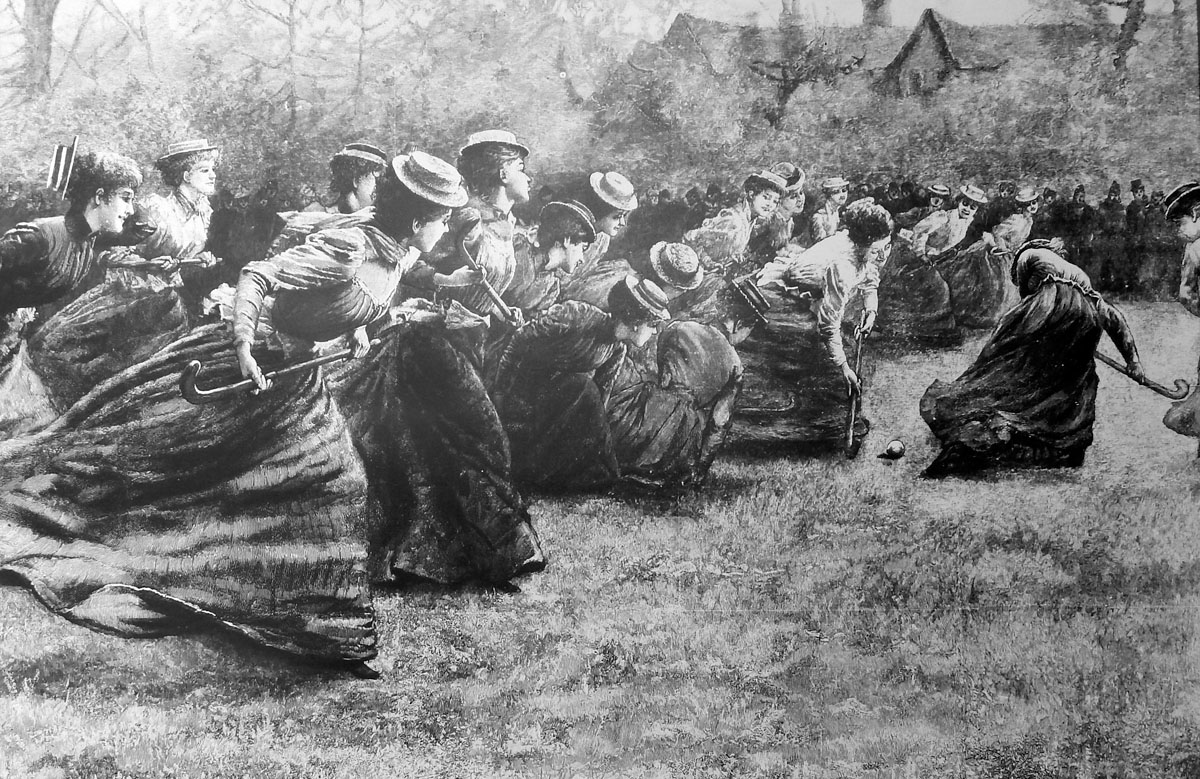In the last decade of the 19th century hockey for women was described as, “being recognized as a very valuable team game. It is a very satisfying form of self-expression of all that is in need of outlet in the healthy, active woman of today”. How it was possible to be very active in the playing uniform of the day is quite remarkable, consisting as it did of a long, thick, serge skirt, fastened at the waist with a tight belt and worn with a stiff collared, high-necked blouse with large, long sleeves. Petticoats were worn under the skirt and a hat worn on the head, all to comply with the accepted standard of dress for young ladies expected at the time. Playing on a wet day increased the weight of the skirts and petticoats and it doesn’t take much imagination to realise the difficulties the early pioneers of our game had to endure, as well as the disapproval of elderly matrons who strongly disapproved of young ladies taking part in sporting activities. One young lady, clutching her hockey stick on her way to play for Wimbledon Ladies Hockey Club was chased down the road by an older lady brandishing an umbrella who called her, “a disgrace to your sex”. Many players in those days did not go out with their parents’ blessing, quite a few found it necessary to creep out by the back door while fathers and mothers were having an afternoon nap in the drawing room.

The Bergman-Österberg Physical Training College First Eleven wearing an early ‘gymslip’ design, 1896-97.
From the Ethel Adair Roberts’ album; courtesy of The Österberg Collection.
Change was to come at the instigation of Martina Bergman-Österberg who was the founder in the late 1880s of the first Physical Training college for women, the Hampstead Gymnasium, later known as Dartford College of Physical Education after the college’s relocation to Dartford in 1895. It was Madame Österberg who brought us the games mistress, the ‘gymslip’ and physical activities such as gymnastics and games for schoolgirls. By the early 1890s the games her students were playing were tennis and cricket, wearing loose-fitting, long-sleeved gymnastic costumes unhindered by stays or petticoats. One of the students, Miss Mary Tait, went one better by designing a simple pleated tunic which reached the ground when the wearer knelt. Part of the inspiration for the design of the tunic may have come from a painting viewed by Madame Österberg in the National Gallery, Portrait of a Young Man by Andea del Sarto, c.1517.
For some time, there was a variation in length and material and the choice of blouse worn underneath, but by 1897 the new ‘gymslip’ was adopted by many schools and indeed became the everyday uniform for girls’ schools well into the 20th century.

Portrait of a Young Man by Andrea del Sarto. Acquired by the National Gallery, London in 1862. Oil on linen, c.1517. Might this be the painting that inspired Mary Tait and Martina Bergman-Österberg to conceive the iconic ‘gymslip’?
© Copyright The National Gallery, London. CC BY-NC-ND 4.0
Appreciate the painting in high resolution detail on the National Gallery website.
The new college in Dartford had 14 acres of ‘pleasure grounds’ and there was ample room for a hockey pitch. The Bergman-Österberg Physical Training College hockey team of 1898/1899 are pictured wearing the new tunics which would have undoubtedly given them an advantage when playing against other teams dressed in the more traditional style of the end of the 19th century. In 1910 one of the Dartford students stirred up a hornets’ nest when, selected to play hockey for Kent, she arrived to play in her college tunic. With the rest of the players wearing regulation skirts, less than six inches from the ground, her action led to the appearance of a letter in the Hockey Field magazine on 27 January 1910.
“Dear Madam, the attention of many hockey players has been drawn by their parents and guardians to the various portraits that have appeared of Kent’s new outside left who plays for the County in her College tunic. That costume is without doubt ideal in that it cannot hamper the movements of the wearer; but at the same time it does not suit itself to public grounds. To show the adoption of this dress for public matches may prove detrimental to hockey. I quote an extract from a letter received by a county player from her fiancé. ‘Please look at page 874 of the Sporting and Dramatic and see the awful apparition who plays for Kent. If there is any chance of you wearing kit like that my foot comes down bang and you have no more hockey.’”
What would the author of this letter and the county player’s fiancé think of the kit worn by the players of today?

Kathleen Doman, Hilda Light, Edith Rebecca Clarke, Joyce Wolton and Ursula Doris Bellchamber (née Croxton-Smith), taken c.1918-20. Doman (1917), Clarke (1906) and Wolton (1914) were Bergman-Österberg Physical Training College alumni.
Courtesy of The Österberg Collection.

England women play Ireland at Richmond on 11 March 1901. Illustration by Fred Pegram, reproduced in The Sphere on 23 March. Neither the national, territorial or county teams were quick to adopt the innovative attire of the Physical Training colleges.








